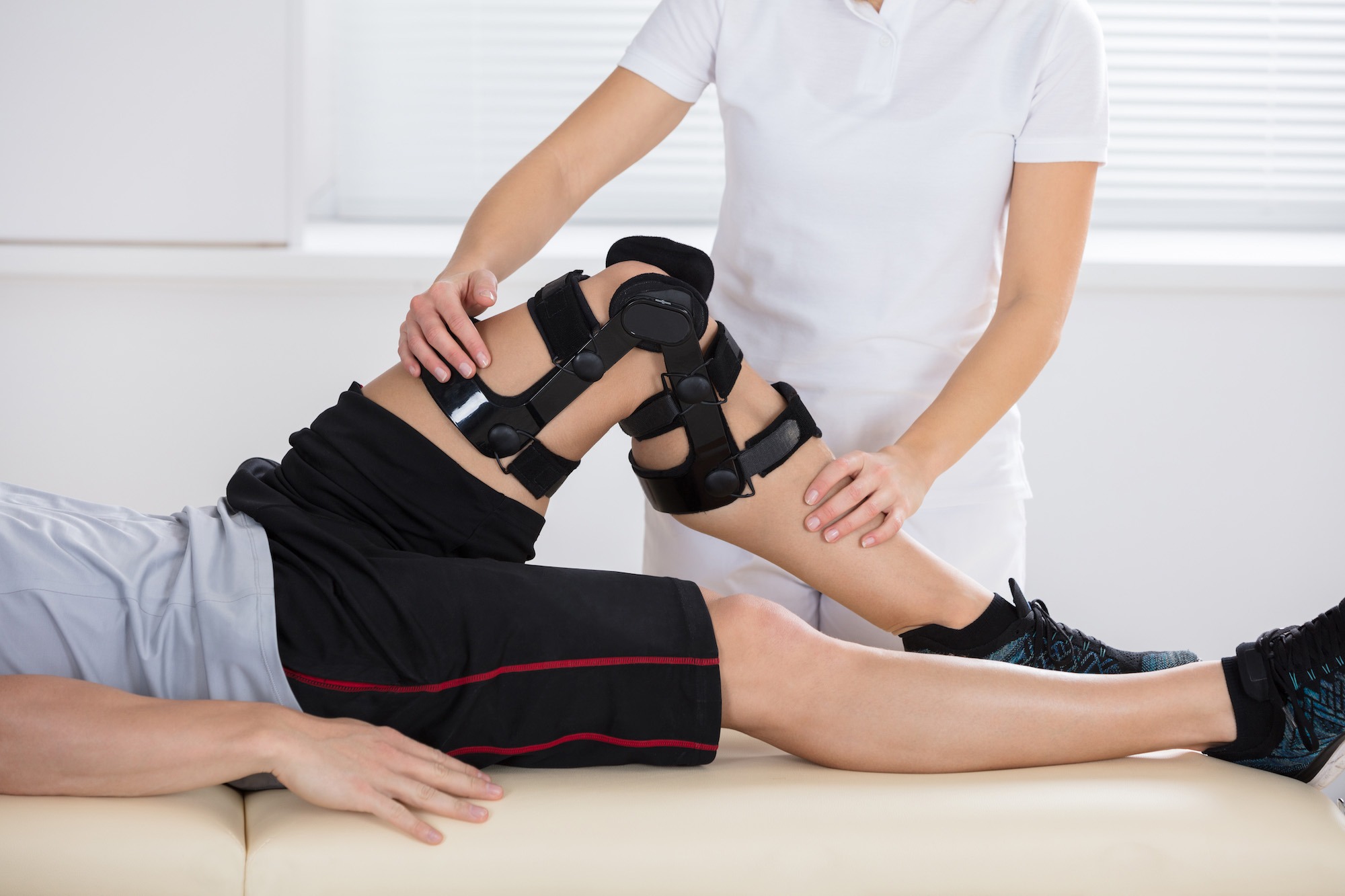Knee Pain Treatment
JL PhysioFit proudly provides expert injury rehabilitation and physiotherapy in Ponteland, North Newcastle, and the surrounding areas.
At JL PhysioFit, we follow a structured 4-step approach to help you recover quickly and confidently. We start by assessing your pain and identifying what’s driving it, then begin treatment using hands-on techniques to reduce pain, stiffness, and nerve tension. From there, we progressively build your strength and mobility so your body is more resilient and less likely to flare up again. Finally, we guide you on how to maintain your progress long-term, giving you a clear plan to stay pain-free and moving well.
What Our Clients Say...
The knee joint is complex and comprised of many components, yet simple in terms of movements - bends, straightens & slight rotation.
Due to the number of structures that make up and control your knee, it makes it vulnerable to a number of injuries.
Anatomy of the knee joint?
The knee joint is the largest joint in the body and is comprised of the articulation between the bottom end of the femur (thigh bone) and the top of the tibia (shin bone). The knee cap (patella) is located on top of these two bones and glides in a groove when you bend and straighten your knee.
The ends of these bones are covered with smooth articular cartilage, a substance that protects the bone and also aids movement.
Between the joint space lies our menisci, one on the inside (medial meniscus) and one on the outside (lateral meniscus). These act as shock absorbers for the knee joint.
Then we have our knee ligaments that attach bone to bone and provide stability to the knee. We have two main ligaments within the knee joint, known as your ACL and PCL. Then we have two ligaments that run down either side of the knee joint known as your LCL and MCL.
Finally, we have various muscles that attach in and around the knee joint that allow us to move and control the knee. These muscles are attached via our tendons.
How knee pain might show up in your life?
Pain when going up and down stairs
Pain when running, walking or squatting down
Pain first thing in the day
Pain with gardening or activities on your knees
Knee locks or gives way on you
Pain may gradually get worse the longer you sit
Struggle with socks and shoes
Reaching for pain killers
Where you might feel pain?
On the outside of your knee
Deep within the knee or under the knee cap
On the inside of the knee
Behind the knee in the crease.
Just below the knee cap at the front
Pain down your leg towards your ankle
How it might feel?
Constant or intermittent Pain (comes and goes)
Dull or diffuse ache
Sharp, catching sensation or giving way
Swollen, red and thickened
Lump behind the knee
Why do you get Knee Pain?
There are a number of reasons why someone might develop knee pain, and getting a good history from the patient is important to lead us to the correct diagnosis.
Most common injuries around the knee include sprains, strains and tears of the soft tissues (ligament, cartilage, muscles and tendons).

Meniscal Tears
Meniscal tears are amongst the most common knee injuries and can result from an acute tear or as the result of degenerative changes that happen over time.
- Often the result of a sporting injury that occurs with a planted foot and twisting mechanism of the knee.
- Can also arise from arthritic changes in the knee, and an awkward twist when getting up from a chair might be enough to cause a meniscal tear.
Most meniscal tears can be managed conservatively, with treatment that helps to improve knee movement and decrease muscle tension, along with a good plan of rehabilitation.
If symptoms are not improving with conservative management, then some tears may need surgery to trim and repair the meniscus. Research shows very favourable results for conservative management however, so surgery should usually be considered as the last choice.
Ligament Injuries
Similar to meniscal tears, ligament injuries are often the result of a sporting trauma or fall that involves a plant and twisting of the knee.
ACL Tear or rupture is one of the most common injuries.
- This ligament provides stability to the knee that prevents excessive forward and back movement of the knee so when it is damaged people will often report that the knee feels unstable and gives way on them.
Please head over to our ACL Rehab page to find out more.
Other ligaments that can be damaged include your PCL, MCL and LCL, which are the other main ligaments that support your knee.
Again, conservative management is often the best way forward but surgical options can be suitable for the right candidate.
Anterior Knee Pain
- Quads Rupture
Your quadriceps are the 4 muscles that live on the front of your thigh, and they attach into the knee cap via your quadriceps tendon (just above the knee cap).
If you’ve experienced a trauma to the leg or you feel a pop after kicking a ball for example followed by pain that is centred around the top of your knee, or you see a balling like appearance of your muscle in your thigh, you may have ruptured your quad muscle/tendon.
- Tendinitis / Tendinosis, Bursitis
If you have pain that is centred above or below the knee cap with no obvious trauma then you might have a tendinitis/tendinosis issue. This is where the tendon becomes painful due to a number of factors like overuse, overload, weight and degenerative changes that occur with ageing.
Similar pain can also be felt due to bursitis, which is a condition in which a fluid filled sac (or bursa) that lives between the tendon and the knee joint gets inflamed and painful.
- Knee Cap Pain (Patellofemoral Pain)
This term is used to broadly describe pain that is experienced around the front of your knee cap. It is also referred to as “runners knee” or “jumpers knee” as it is common in people who participate in these types of sports.
Often people that struggle with this type of pain have unwanted forces coming from above and/or below the joint that are causing compression or alignment issues of the knee cap.
It is common for these problems to flare when getting to a certain mileage of a run, indicating a load capacity issue that needs to be addressed.
Lateral Knee Pain
This refers to pain that is felt on the outside of the knee and is usually synonymous with iliotibial band (ITB) syndrome or ITBS.
The ITB is a strong structure that comes from the pelvis and outer hip, and runs down the outside of your leg attaching into the knee cap and shin bone.
With activities that repeatedly bend and straighten the knee like running and walking, this can lead to a build-up of excess pressure on structures like the ITB until pain is experienced.
Other structures that can be causing pain here are the outer or lateral meniscus, along with certain tendons.
Posterior Knee Pain
Pain that is experienced at the back of the knee can come from referred pain in the front of the knee, making a thorough assessment crucial to getting the correct diagnosis.
Other common sources of pain here include a Bakers Cyst. This is where you get a build-up of fluid in the back of your knee largely due to arthritis or other damage to the knee joint. A cyst forms when excess synovial fluid fills in one of your bursas called the popliteal bursa.
Other causes of posterior knee pain include tendinitis of muscles such as your hamstrings and other smaller muscles.
Osteoarthritis (OA)
OA is one of the most common sources of pain in the knee. OA can develop in your knee joint through genetics, poor lifestyle factors and limited exercise habits.
People will struggle with pain and stiffness in the knee joint, and getting up and down stairs.
The knee can become sore in the mornings and even when seated for prolonged periods. The knee may also become hot and swollen.
More can be read on OA (here).
How do we treat Knee Pain?
As you can see there are a number of conditions that can cause pain in the knee so it is imperative to start with an assessment.
This is the first part in our 4-step system to assess and treat your knee pain as outlined below. This ensures you have the best possible chance of getting better and the problem not returning in future.
1) Assess
First we listen to you and take a detailed history of your knee pain and problem. Then we assess your knee, ankle/foot, hips and lower back using simple movement tests and screens.
We then explain your likely diagnosis and proposed treatment plan of exactly what we need to do to get you better.
2) Mobilise
Soft tissue massage and mobilisation
Joint mobilisation
Acupuncture and Dry Needling
Muscle Energy Techniques
Taping
Advice around lifestyle, posture and ergonomics.
3) Strengthen
4) Optimise
How do I get started?
Like to speak to someone first?
No problem, please call the main desk and if needed we can have a physio call you back to discuss your specific situation.





